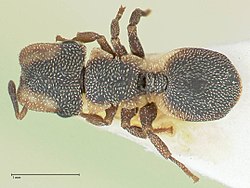| Cephalotes pinelii | |
|---|---|
 | |
| Scientific classification | |
| Domain: | Eukaryota |
| Kingdom: | Animalia |
| Phylum: | Arthropoda |
| Class: | Insecta |
| Order: | Hymenoptera |
| Family: | Formicidae |
| Subfamily: | Myrmicinae |
| Genus: | Cephalotes |
| Species: | C. pinelii |
| Binomial name | |
| Cephalotes pinelii (Guérin-Méneville, 1844) | |
Cephalotes pinelii is a species of arboreal ant of the genus Cephalotes , characterized by an odd shaped head and the ability to "parachute" by steering their fall if they drop off of the tree they're on. They're also known as gliding ants. [1] [2]